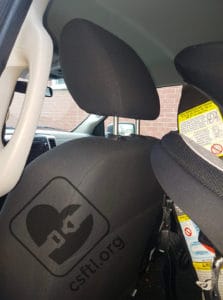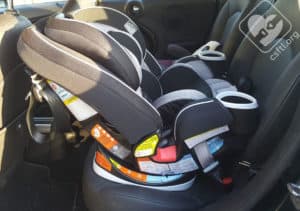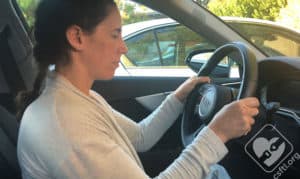When it comes to reasons why caregivers want to turn their child’s car seat around from rear facing to forward too soon, we’ve heard them all.
- Rear facing car seats take up so much room!
- I can’t fit a rear facing car seat in my small car!
- We’re too tall to keep our children riding rear facing past the minimum height and weight limits!
- A rear facing car seat pushes the front row too far forward!
As CPSTs we’ve heard this a lot. Fitting everyone safely in the car as families grow is an ever-evolving challenge. The type of car seat a child needs changes as that child grows, the vehicle has to accommodate that change while keeping every passenger safe. It’s a challenge that we take on in our work as CPSTs and in our own lives as parents. We’ve been there: moving our little darlings around can be one of the (many) frustrating parts of parenting. So for everyone with rear facing kids, we’ve compiled some tips and tricks to maximize your front seat space and still keep your Littles as safe as possible.
The Best Car Seat? The One That Fits Your Car
We say this a lot — the best car seat is the one that fits your child, fits your car, and that you’ll use correctly every time. That middle criteria (how the seat fits in your vehicle) can be flummoxing: how can you know which car seat fits your car without actually installing the thing? Installing the seat in your vehicle is the best way to know, but you can start with our recommended seats, ask some knowledgeable folks, and then try out different seats with a CPST or at a baby store.
Recline Angle
A car seat’s allowable recline angle can make a big difference in how a rear facing car seat fits in the vehicle. The type of vehicle is also a factor: minivans tend to offer a larger footprint while smaller sedans and SUVs present a much more formidable challenge. If space in the vehicle is at a premium, whether the challenge comes from installing a large car seat in a smaller car or behind a tall adult, we’d suggest choosing a convertible car seat that can be installed more upright for older babies and kids.
While tiny babies need to be at a safe angle to protect their airways, older children can generally tolerate sitting more upright in their car seats. Convertible car seats for older children that can be installed at a more upright angle can be much more compact front to back than a rear facing only infant seat. In most cases, moving from a rear facing only infant car seat to a more upright rear facing convertible or multmode car seat can dramatically decrease the amount of front to back space that the car seat requires.
Try Installing in Different Locations in the Vehicle
Car seats can be installed via different methods (LATCH or the vehicle seat belt) and in different seating positions in the back seat. The selection of seating position and, sometimes, the installation method can impact how much space a car seat requires.
It’s critical to follow all the directions in your car seat’s manual and your car’s manual, but there are usually a few options when deciding where and how a car seat will fit in a car.
Consider the Loading/Unloading Process
When trying to make more room for the driver and front seat passenger, consider the most convenient seating position for children who ride rear facing. In some cars, the center seating position allows more room for the front seats to move back. In other cars, the center seating position just steals room from both the passenger and driver: in those cars, perhaps inconveniencing the passenger is a better choice than the driver.
Many cars are not symmetric side to side. Installing a car seat on the passenger side of the back seat may be vastly different from installing a car seat behind the driver’s seat.
Sometimes, a vehicle seat belt install or a LATCH install can impact the final location of an installed car seat, take the time to try out all your different options and be willing to be surprised.
Install the Seat More Upright
The vehicle seats in the front of the car are designed to fit different body types, they often have a recline feature that can help with the fit. Most people don’t need to lay back while the car is in motion, in fact, most vehicle manuals discourage this and instead, encourage a more upright seating position. If you’re used to driving or riding like you’re lounging on a recliner, you can gain quite a bit of space in the back seat by adjusting your seat back in the front seat to a more upright position. It’s also a safer seating position for you because the airbag needs to hit the right place on your body to work correctly.

But un-reclining the driver’s seat only a little leaves plenty of room for the rear facing seat in this Ram crew cab
Even if you aren’t sitting totally upright, un-reclining the front seats just a bit might be the difference between fitting your legs in and feeling like your knees are in the dashboard.
Move the Steering Wheel — In/Out and Up/Down
Some cars include telescoping steering wheels that move in and out and in up and down. We find that lots of parents have never investigated this feature of their car: if you’ve never needed to move your steering wheel in this way you may not know how much of a difference this simple adjustment can make.
Check your manual, but in most vehicles the steering wheel will be released with a flap under the wheel. Once the wheel is released, try pushing the wheel toward the front of the car and pulling it toward you, then move it up and down. By moving the wheel closer to the front of the car or further down you may be able to open up room to move your seat forward and away from a rear facing car seat that’s installed behind the driver.
Move the Vehicle Seat Up and Down
In concert with moving the steering wheel, the front vehicle seats may also have height adjustments. In some cars, sitting lower can allow the rear facing seat to clear the front seat at the top and in other cars, sitting higher can allow the rear facing car seat to not touch the front seat. When you are trying to gain space for a rear facing seat, try moving the front seat up as well as down to find that sweet spot where the rear facing seat is properly installed and reclined and the driver or front seat passenger can comfortably drive or ride.
Have Adult Passengers Sit in Back
The last option for an adult is also a fine one: grown ups can sit in the back seat. Sometimes, an adult can’t sit comfortably in front of a large rear facing car seat. If there’s an open seating position in the back seat, there’s no reason that adult can’t ride in the back seat!
In Summary
Our goal is so simple: to keep children in the right seat for their size and age. There are many small things that can help make rear facing car seat installations work better for the whole family so that your kids can stay rear facing as long as possible. We hope some of these tips help you make your ride more comfortable for everyone in the vehicle.








